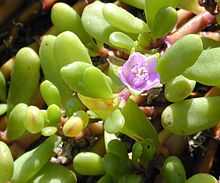Sesuvium portulacastrum
| Sesuvium portulacastrum | |
|---|---|
 | |
| Scientific classification | |
| Kingdom: | Plantae |
| (unranked): | Angiosperms |
| (unranked): | Eudicots |
| (unranked): | Core eudicots |
| Order: | Caryophyllales |
| Family: | Aizoaceae |
| Genus: | Sesuvium |
| Species: | S. portulacastrum |
| Binomial name | |
| Sesuvium portulacastrum (L.) L. | |
Sesuvium portulacastrum is a sprawling perennial herb that grows in coastal areas throughout much of the world. It is commonly known as shoreline purslane or (ambiguously) "sea purslane," in English, and dampalit in Tagalog.
Description
It grows as a sprawling perennial herb up to 30 centimetres (12 in) high, with thick, smooth stems up to 1 metre (3.3 ft) long. It has smooth, fleshy, glossy green leaves that are linear or lanceolate, from 10–70 millimetres (0.39–2.76 in) long and 2–15 millimetres (0.079–0.591 in) wide. Flowers are pink or purple.[1][2]
Taxonomy
It was first published as Portulaca portulacastrum by Carl Linnaeus in 1753.[3] Six years later Linnaeus transferred it into Sesuvium,[4] and it has remained at that name ever since, with the exception of an unsuccessful 1891 attempt by Otto Kuntze to transfer the species into a new genus as Halimus portulacastrum.[5]
Distribution and habitat
It grows in sandy clay, coastal limestone and sandstone, tidal flats and salt marshes,[2] throughout much of the world. It is native to Africa, Asia, Australia, North America and South America, and has naturalised in many places where it is not indigenous.[6]

Chemistry and Medicine
Fatty acid composition:- palmitic acid (31.18%), oleic acid (21.15%), linolenic acid (14.18%) linoleic acid (10.63%), myristic acid (6.91%) and behenic acid (2.42%) The plant extract showed antibacterial and anticandidal activities and moderate antifungal activity.[7]
Human consumption
Sesuvium portulacastrum is eaten in the Philippines, where it is called dampalit in Tagalog. The plant is primarily pickled and eaten as atchara (sweet traditional pickles).
External links
References
- ↑ Prescott, A. and Venning, J. (1984). "Aizoaceae". Flora of Australia 4. Canberra: Australian Government Publishing Service.
- ↑ 2.0 2.1 "Sesuvium portulacastrum (L.) L.". FloraBase. Department of Environment and Conservation, Government of Western Australia.
- ↑ "Portulaca portulacastrum L.". Australian Plant Name Index (APNI), IBIS database. Centre for Plant Biodiversity Research, Australian Government.
- ↑ "Sesuvium portulacastrum (L.) L.". Australian Plant Name Index (APNI), IBIS database. Centre for Plant Biodiversity Research, Australian Government.
- ↑ "Halimus portulacastrum (L.) Kuntze". Australian Plant Name Index (APNI), IBIS database. Centre for Plant Biodiversity Research, Australian Government.
- ↑ Sesuvium portulacastrum at the Germplasm Resources Information Network (GRIN)
- ↑ Chandrasekaran M., Senthilkumar A., Venkatesalu V "Antibacterial and antifungal efficacy of fatty acid methyl esters from the leaves of Sesuvium portulacastrum L. ". European Review for Medical and Pharmacological Sciences. 15 (7) (pp 775-780), 2011.